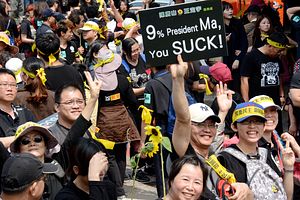During a public address on March 29, Lin Fei-fan, one of the leaders of the Sunflower Movement who has camped out at the legislature since March 18, said that the “330” protest could be called off if President Ma met their demands. As Ma failed to respond according to their wishes during his second press conference, the leadership elected to proceed with the rally, which was scheduled to start at 1pm. Ma, however, argues that he did respond to the protestors’ demands, and wants them to go home so that the legislature can resume its operations.
In response to Sunday’s rally, the government said it would give the organizers until midnight, March 31, to clear Ketagalan Blvd and other areas near the Presidential Office before ordering police to take action. The same day, police announced it had activated 60 elite Night Hawk special forces and deployed them at the barricaded Presidential Office for added protection.
The protest, which according to Chen Wei-ting, another student leader, attracted more people than expected, wrapped up peacefully at about 8pm, with protesters dispersing or returning to the Legislative Yuan, where activities continued. Although organizers estimated the total number of participants at approximately 350,000, police authorities set the figure at 116,000. The Diplomat’s estimate is closer to the upper figure.
Addressing the crowd at the conclusion of the protest, Lin said that as Ma continued to refuse to meet their demands, the occupation of the legislature would continue indefinitely Among other demands, the Sunflower Movement has requested the Cross-Strait Services Trade Agreement (CSSTA) between Taiwan and China, signed in Shanghai in June 2013, be returned and that legislation be implemented to oversee any future agreement between Taipei and Beijing. The Ma administration has not budged on those issues, though it announced on March 30 the creation of an ad-hoc taskforce to evaluate the possibility of holding a “civic constitutional meeting,” another demand of the protesters.
A small counter protest, which attracted a few hundred people, was held at nearby Taipei Main Station in the afternoon, sparking a few heated exchanges as supporters of the Sunflower Movement surrounded them. In another incident, an elderly man threw a painting at a car carrying Chen Wei-ting as the leader was being driven to address the crowd. Police, which provided plainclothes security for Lin and Chen, citing threats against the pair (Lin received a text message warning them to cease and desist or blood would be spilled), said they were investigating the incident.
Premier Jiang Yi-huah, who held unfruitful talks with Lin at the legislature on March 22, told a press conference on March 28 that the government categorically refused pulling out of or renegotiating the CSSTA with China. Ma and other officials maintain that such a concession would “hurt” Taiwan’s reputation abroad and undermine the confidence of other economies in Taiwan’s commitment to trade pacts. Critics of the government counter that such fears are unfounded, as the current impasse over the CSSTA involves several political components stemming directly from China’s sovereignty claims over the democratic island of 23 million people.
With both sides digging in and public support in favor of the activists (63 percent of respondents to a poll by cable network TVBS say they support withdrawing from and renegotiating the CSSTA, against 18 percent who want it passed as is), the Ma government’s options seem to be narrowing. Its image already tarnished by police action at the Executive Yuan (while a majority opposed the students’ occupation of the compound, 56 percent opposed the police methods, versus 35 percent who approved), the administration is unlikely to use force to evict the students at the legislature.
Ma’s strategy may therefore be to simply wear the students out, though this is a gamble that he is not certain of winning. Refusing to make the necessary concessions could lead to pressure within an already faction-riven Chinese Nationalist Party (KMT), of which Ma is chairman, to meet the students’ demands lest the crisis undermine the party’s chances in the seven-in-one municipal elections later this year and the presidential/legislative elections in early 2016. While the unpopular Ma (whose approval rate has been in the single-digits for months) is unlikely to step down, other members of his party could lean on him to move aside as chairman, which could then open the door for rapprochement with the activists.

































